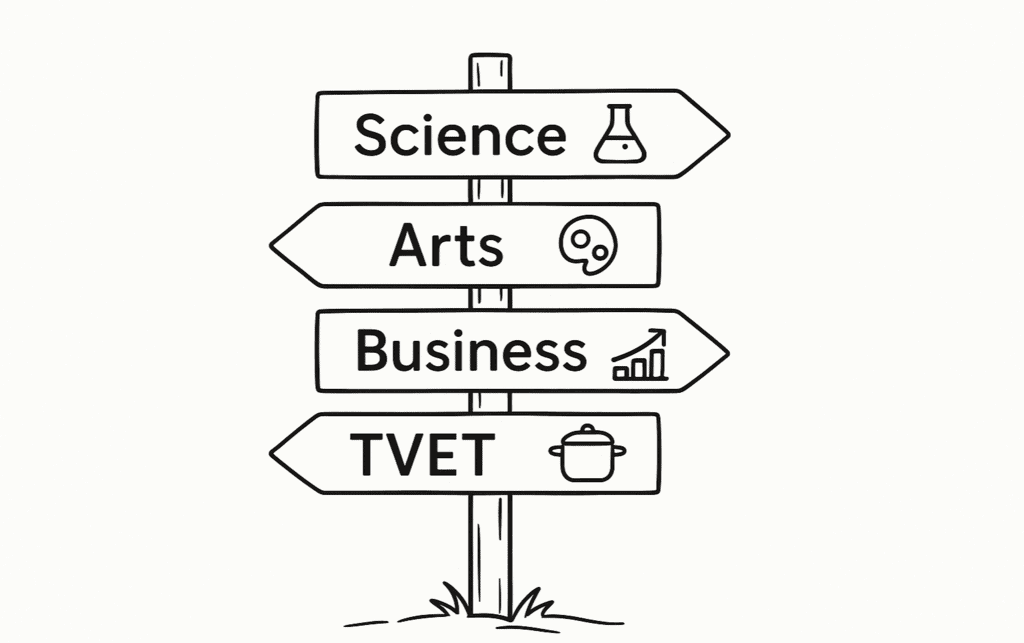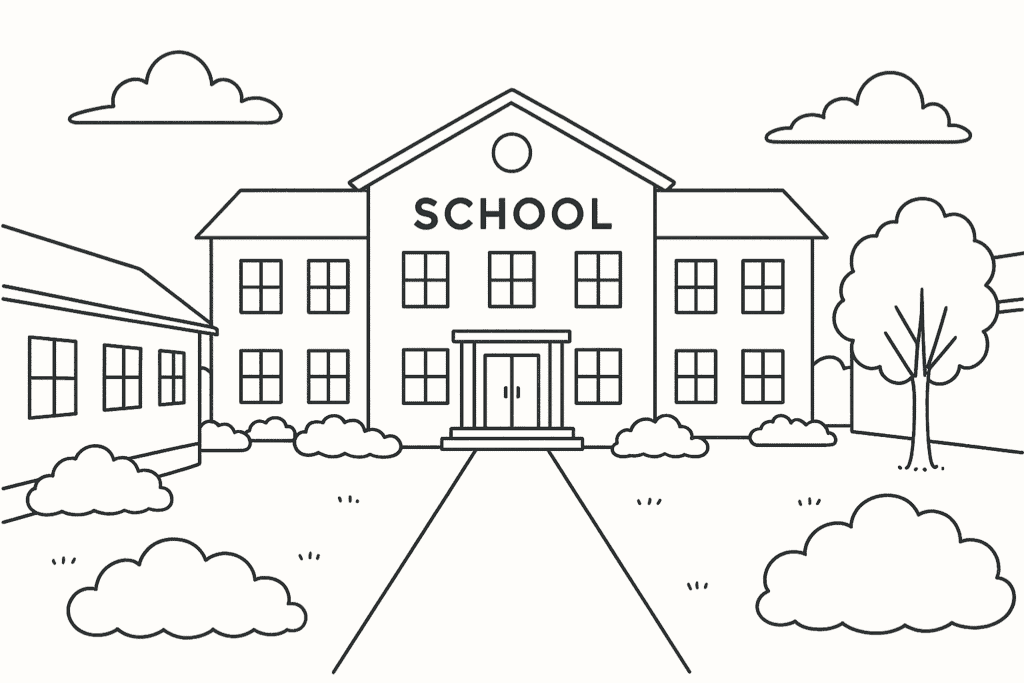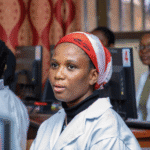Key takeaways
- Before selecting a course, familiarise yourself with the subjects, careers, and university programs associated with it.
- Pick a course based on your strengths, interests, and career goals, not what others think you should do.
- Know the requirements, competition, and facilities before making a decision.
The course you choose in SHS can open doors to specific careers, but it can also limit your options if you’re not careful. That’s why it’s important to choose a course that matches your strengths, interests, and future goals.
In this long guide, we will help you understand your options and make a wise choice for your SHS journey. Take your time and read it, and let us know if you have any questions in the comments below.
Getting started
After JHS, you have two main education pathways to choose from:
- Traditional Senior High School (SHS): This path emphasises a theoretical approach to learning. Students who choose this route most often have to further their education at a university or college before entering the job market or getting a job.
- Technical and Vocational Education and Training (TVET) institutes: This option offers more hands-on and practical training. It prepares students with skills they can use to start working right after school, although they can also continue their education at university if they wish.
Here’s a simple comparison of the two main options:
| Educational track | Career path | Years spent in school |
|---|---|---|
| Traditional SHS | SHS → University → Job market | 3 years |
| TVET Institutes | TVET → Job market, or TVET → Technical University → Job Market | 3 years |
Now that you know the main options after JHS, let’s take a closer look at the different SHS tracks and the course strands or options under each one.
STEM track
While there are now dedicated STEM schools in Ghana, you can study STEM courses in most traditional senior high schools. This track focuses on Science, Technology, Engineering, and Mathematics.
It includes two courses in SHS:
- General Science: Students learn subjects such as Biology, Chemistry, Geography, Physics, Computing, Agriculture, and Further/Advanced Mathematics.
- Business: Students learn subjects such as Accounting, Economics, Business Studies, Further Mathematics, French, and Business Management.
Arts and Design track
The art and design track includes subject disciplines that are artistic and creative. If you’re a creative person, you can consider these three courses:
- General Arts: Students learn subjects such as Government, History, Economics, Literature, Religious Studies, French, Geography, Arts and Design Foundations, Music, Computing, and Advanced/Further Mathematics.
- Visual Arts: Students learn subjects such as Art and Design Foundations, Art and Design Studios, Graphic Design, Textiles, Sculpture, Literature, Basketry, Leatherwork, Ceramics, Picture Making, Further Mathematics, Advanced Mathematics, Computing, and Performing Arts.
- Home Economics (Clothing): Students learn subjects such as Clothing and Textiles, Biology, Further Mathematics, Advanced Mathematics, Family Resource Management, Entrepreneurship, Computing, French, and Physical Education and Health.
Technical-Vocational-Livelihood track
The technical-vocational track is ideal for students who enjoy working with their hands or want to build job-ready skills. It includes both technical and practical subjects, as well as some theoretical aspects.
Even though it’s more practical than STEM and Arts, it’s not as hands-on as the full TVET path. Courses like Visual Arts and Home Economics also fall under this track.
Students learn subjects such as Entrepreneurship, Food and Nutrition, Family Resource Management, Biology, French, Further/Advanced Mathematics, and Food Science.
How to choose the right senior high school course?
Now that you know the different tracks and courses you can choose from, here is how to choose the right one:
Part #1: Evaluating the available options

No matter which course you choose, every SHS student studies four core subjects: Integrated Science, Social Studies, English Language, and Core Mathematics. Your elective subjects depend on the course you choose.
Here are some career opportunities available based on the course you study or choose in SHS:
| Course | Example university programmes | Example career areas |
| General Science | Actuarial science, medicine, optometry, fisheries, environmental studies, and agriculture | Health, engineering, fisheries, agriculture, auditors, and biomedical research |
| General Arts | Political science, sociology, psychology, international relations, communication studies, and languages | Law, journalism, accountancy, teaching, public administration, auditing |
| Visual Arts | Music and theatre, fine arts, architecture, communication studies | Fashion, performing arts, interior design, advertising, talent management |
| Business | Accounting, marketing, human resource management, and economics | Entrepreneurship, banking, finance, management, auditing |
| Home Economics | Nutrition and dietetics, nursing, clothing and fashion, hospitality management | Catering, hospitality management, teaching, and fashion |
At this point, it’s easy to feel like the choice you make now will lock you into one career forever, but that’s not the case.
While each course prepares you for specific paths, there’s still room for change along the way. The table below shows how flexible each course is in two ways:
- How much choice you have in selecting subjects
- How many different careers or university programmes you can pursue after SHS
They are rated on a scale of 1 to 5, where 1 = least flexible and 5 = the most flexible:
| Course | Subject choices | Career paths | ||
| Flexibility score | Explanation | Flexibility score | Explanation | |
| General Science | 1
| Students are mostly restricted to the fields of Biology, Chemistry, Physics, Agriculture, and Mathematics. They mostly have only computing and French as alternatives. | 5 | Graduates can apply for many science and non-science programmes. Highly versatile. |
| General Arts | 4 | Lots of subject combinations. Some schools even allow students to take electives from other tracks and courses. | 4 | Open doors to many fields, except those related to science, such as medicine or pharmacy. |
| Visual Arts | 3 | Students have some variety, but can’t usually take certain general art and general science courses. | 2 | Graduates are restricted to the arts and design industries and programmes. Limited access to other areas. |
| Business | 2 | Subject restrictions are tight, but they are allowed more substitutions and combinations than science students. | 4 | Graduates can enter many industries and programmes, except those requiring a science background. |
| Home Economics | 3 | Some flexibility is available to combine science and arts subjects (such as Biology and Economics), but options are still limited. | 3 | Decent flexibility, especially if paired with science or arts subjects. Still mostly leads to vocational fields. |
Both tables above don’t paint the whole picture, but it’s a good background to build upon when doing further research.
Part #2: Evaluating yourself

Choosing the right course also means understanding who you are. That is, your strengths, interests, and future dreams. Here are three big questions to help you decide:
a. What are your career goals?
This question helps you imagine your ideal work environment and understand the kinds of jobs that bring you the most fulfilment. Fulfilment could be jobs that bring you more money, prestige and respect, or even just happiness.
Ask yourself:
- What experiences have I had that I enjoyed?
- What kinds of tasks can I do repeatedly without getting bored?
- Where do I see myself in three, five, or even ten years?
- How much money would make me feel comfortable?
- Do I want to work in an office, a lab, a classroom, or outdoors?
If you can picture your dream job, you can look at which SHS tracks lead there.
b. What are your academic strengths and weaknesses?
It’s now time to be completely honest with yourself. Every course has its challenges, but some may feel impossible if they don’t match your strengths.
Even if you love a career idea, you need to ask: Will I be able to go through the training and learning that comes with it?
You must also think about your JHS subjects:
- Which subjects do I do well in and enjoy?
- Which ones do I struggle with, even when I try my best?
- If I try harder, which subjects do I believe I can improve in?
These will help you understand what you can and cannot do, what requires more effort or hard work, and what might not be worth the stress.
c. What are your preferences and interests?
Now that you’ve pictured your dream job and assessed your strengths, it’s time to determine which path excites you the most. Look at the subjects and topics in the course you’re considering.
- Do the topics make you curios or bore you?
- Which subject has topics that you love?
The answers to these will help you understand how you truly feel about your decision. It’s also a good way to shortlist your options.
Now, to the final part.
Part #3: Evaluating the senior high schools you have chosen

Different schools have different subject combinations. This is very important, so you must check your school choices carefully. Here are three key things to consider:
a. The competitiveness of the school and course compared to your grades.
So you have a list of what courses you want, the subjects you’d love to study, and what schools offer these options.
But just because you want a school doesn’t mean you’ll automatically get it. You need to evaluate how competitive your choices are.
Ask yourself:
- How competitive is the school?
SHSs are grouped into three grades: A (very competitive), B, and C (less competitive). Each has a BECE grade range that it accepts. The better your grades, the more options you have.
- How competitive is that course in the school?
Some courses are more challenging to get into than others. For example, General Science might be more competitive than General Arts.
But this generally depends on the school, the number of available slots for each course, and the number of students who apply for admission.
- Do my grades fall within the competition ranges of these schools or their courses?
Look at your BECE performance and ask yourself if it matches the level of competition at the schools and courses you want. If not, consider other options where your grades give you a better chance of success.
b. Facilities available in your chosen schools for the courses you are interested in.
Some schools are known for some courses, and they usually have better facilities for those course. Check if the schools on your list have the proper facilities for the course you want to study.
c. Ask students in the schools you have chosen what they think of the courses that interest you there.
You can also visit the schools or speak with students who already attend them. You can ask about the courses you are interested in, as well as the teaching and learning experience. Students already in the school can give you real, honest answers about everything you need to know.
5 common mistakes most students make
To wrap up, here are some mistakes to avoid when selecting a course:
- Choosing a course without knowing your strengths and weaknesses.
- Letting your friends’ peer pressure influence your course choice.
- Not taking the course and the school selection process seriously.
- Failing to research schools thoroughly.
- Choosing a school based on what other people think.
FAQs
Can I change my course once I am placed in a school with a particular course?
It depends on the school. Some may allow it based on your grades or internal assessments, while others may not permit it at all.
What happens after I complete SHS with a course, but my career plans change?
You can still change paths. You may need to take additional classes, write exams, or undergo further training, especially if the new path is significantly different from your SHS course. The TVET path, however, may require more time and effort.
Can I personalise the course curriculum?
Some schools allow you to choose from subject combinations or substitutes, but this depends on the course and the school.
Conclusion
Choosing a course for SHS is a big step, but it doesn’t have to be overwhelming.
Focus on what you enjoy, what you’re good at, and where you want to go in the future. Take your time, do your research, and don’t be afraid to ask for guidance from your parents or teachers.
If you have any questions, please don’t hesitate to engage with us in the comments section below.












6 Comments. Leave new
I am in Jhs 3 and my best subject is maths but I don’t know the course I should choose because my dad wants me to do science and I don’t know whether to choose science or business
Hi Perfect 😊, It’s great that you already know maths is your strong subject; that’s an excellent start!
If you really enjoy solving problems, doing calculations, and understanding how things work, Science might also suit you, especially courses like Engineering, Computer Science, or Architecture.
But if you’re more interested in how money, trade, and management work, or you’d like to start your own business someday, then Business would be a better path.
Take some time to think about what excites you more, we advise discussing it more with your dad or teachers to help you decide.
Change my course to General Art
Hello Tweneboah, we’re not sure what you mean. Can you ask again?
What will be the right course for someone who enjoys reading and writing, favourite subjects being English, Science, and Computing. I love languages and Music as well.
Hello Dahlia, if you enjoy reading, writing, languages, and music, General Arts may be the best course for you. It has subjects like Literature, History, Government, French, and sometimes Music.
Because you also like Science and Computing, you can pick a school that allows you to add those to your General Arts subjects.